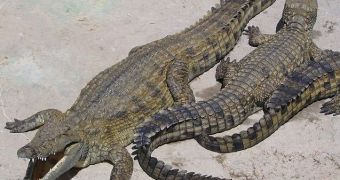Scientists have recently discovered that a fearsome crocodile might have been one of the predators feasting on ancient humans. In those times, when our ancestors were trying to make a life for themselves in Africa, the animals they chased often had a mind of not being eaten. Rather, they preferred eating the humans in return, and some were apparently quite successful at teaching the earliest humans not to bite off more than they could chew. One of these beasts was a massive crocodile that might have very well been the largest predator our ancestors encountered before leaving the continent.
The crocodile, which was only recently discovered, was aptly named Crocodylus anthropophagus, which is the scientists' way of saying it was a crocodile that readily ate humans. In addition to theoretical predictions that the two species might have crossed paths from time to time, it would appear that some of our most unfortunate ancestors actually had violent run-ins with the creatures. This was evidenced by human bones bearing the marks of this crocodile's teeth. The predator's appearance was apparently able to strike fear in the minds of primitive men and women, mostly because it had a deep snout, larger than that of modern crocodiles, and some prominent, triangular horns adorning its skull.
“They would have been visible mostly from the side as projections behind the eye. If you looked at them from the front, you would have seen ridges projecting upwards,” University of Iowa vertebrate paleontologist researcher Christopher Brochu said. He added that some modern varieties of the beast, the Cuban and Siamese crocodiles, still had similar horns on their heads. “Males will use these in mating season to show off. While submerged they kind of tip their head forward, showing off the prominence of their horns to females,” he explained, quoted by LiveScience.
The newly found fossil was unearthed from the Serengeti Plains of Tanzania. There, excavations conducted in 2007 at the famous Olduvai Gorge revealed the partial skull and skeleton of the reptile, embedded in the same layers as our ancestor's remains. The animal is estimated to have lived some 1.89 million years ago, at the same time that early humans were producing stone tools. These artifacts were also discovered at the Gorge, which is famous for being one of the main supports of the theory that humans originated in Africa and not elsewhere.
“I can't guarantee these crocodiles were killing people, but they were certainly biting them. Our ancestors would have had to be cautious close to the water, because the water's edge at Olduvai Gorge would have been a very dangerous place,” the scientist added. The remains from the hominids were found in the same layer as the reptile's remnants, not 300 feet from each other. “[The animal] was probably as large as a modern Nile crocodile, one of the largest living crocodilians at between 18 to 20 feet. One thing to bear in mind was that while these crocodiles are not necessarily bigger than the ones today, hominids back then were smaller than we are today, so the crocodiles would have been relatively quite a bit larger,” Brochu concluded.

 14 DAY TRIAL //
14 DAY TRIAL //